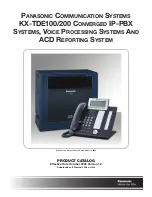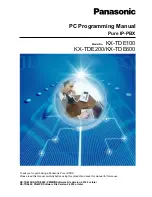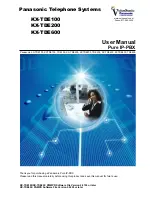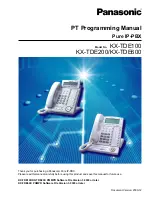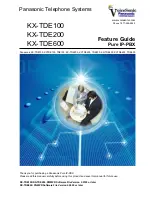
Glossary
Appendix
Page 66
2004 by TELES AG Berlin, Version 2.0/iPBX8TRe/6.02, Issue: May 1998
Term
Explanation
Carrier access prefix
A 2 or 3-digit prefix before the actual call number to inform the local ex-
change that the connection is to be routed over an aternative provider. It is
the first part of the carrier access code (see above). The number is needed
when dialing in to the networks of this carrier.
Carrier Identification
Code(CIC)
A 2 or 3-digit prefix before the actual call number to identify a carrier in the
telephone business (telecommunications, telephone companies, network
carriers). It is the second part of carrier access code (see above). The
number is needed when dialing in to the networks of this carrier.
Carrier Selection
Selection of the network carriers using a code (
↑
Carrier Identification
Code) before the actual call number. The connection is made by the ex-
change to the appropriate network carrier. You can register yourself per-
manently with a network carrier or decide each time you dial a call number
(Call by Call). For the Call-by-Call method, you can configure the automatic
calling through your preferred network carrier in the TELES.iPBX 8TR Box.
CCBS
↑
Callback on busy
CFB
Call Forwarding on Busy
↑
Call forwarding
CFNR
Call Forwarding No Reply
↑
Call forwarding
CFU
Call Forwarding Unconditional
↑
Call forwarding
Charge account or
Charge limit
You can set charge accounts for certain extensions. This allows the user to
conduct calls until the given amount of charge units are consumed.
Emergency numbers can still be dialed after depleting the charge account.
Charge display
The charges for the current conversation are shown on the telephone’s
display. For that the TELES.iPBX 8TR Box converts the advice of charges
information that it receives from ISDN during the connection into charge
pulses that are used by analog terminal devices to display the charge.
Charge evaluation
The TELES.iPBX 8TR Box records data on all telephone calls and
charges. To evaluate them you need a TELES.ISDN adapter with the
TELES.ISDN device manager attached to the same ISDN line.
Charge pulses
↑
Charge display
CIC
↑
Carrier Identification Code
CLI or CLIP
Call Line Identification Presentation – Transmission of the caller’s tele-
phone number “caller ID” to the called party
The call number of calls to the TELES.iPBX 8TR Box can only be dis-
played using TELES.OnlinePowerPack.
CLIR
Call Line Identification Restriction – The transmission of the caller ID to the
called party is suppressed. Press
#
before dialing the outside line access
and the call number for the case-by-case call line identification restriction
Comfortable call transfer By means of the TELES.Family Patent the transfer of calls from a port of
the TELES.iPBX 8TR Box to further TELES-ISDN devices on your ISDN
point-to-multipoint line. The device ID of the destination terminal device is
necessary.
Conferences
Multiple connection with three parties. All persons partaking in the connec-
tion can telephone with each other.
D channel
An ISDN channel which controls information for the connection setup and
tear down of B channels etc. between terminal and switching center and/or
the ISDN net.
D channel protocol
Protocol for ISDN signaling. In the US, the common protocols are: AT&T,
Northern Telecom and Siemens. In Europe, the DSS1 protocol is standard.
Detailed call record
↑
Call list
Dial through
The point-to-point connection is intended especially for attaching ISDN
PBXs. You receive a trunk number to which the extension number is
added. This way the caller can dial through directly to the extension.
↑
point-to-point connection
Direct call
Automatic connection setup when a line is opened, i.e. when the receiver
is lifted a preset number is dialed. Sometimes known as “baby call”.
























